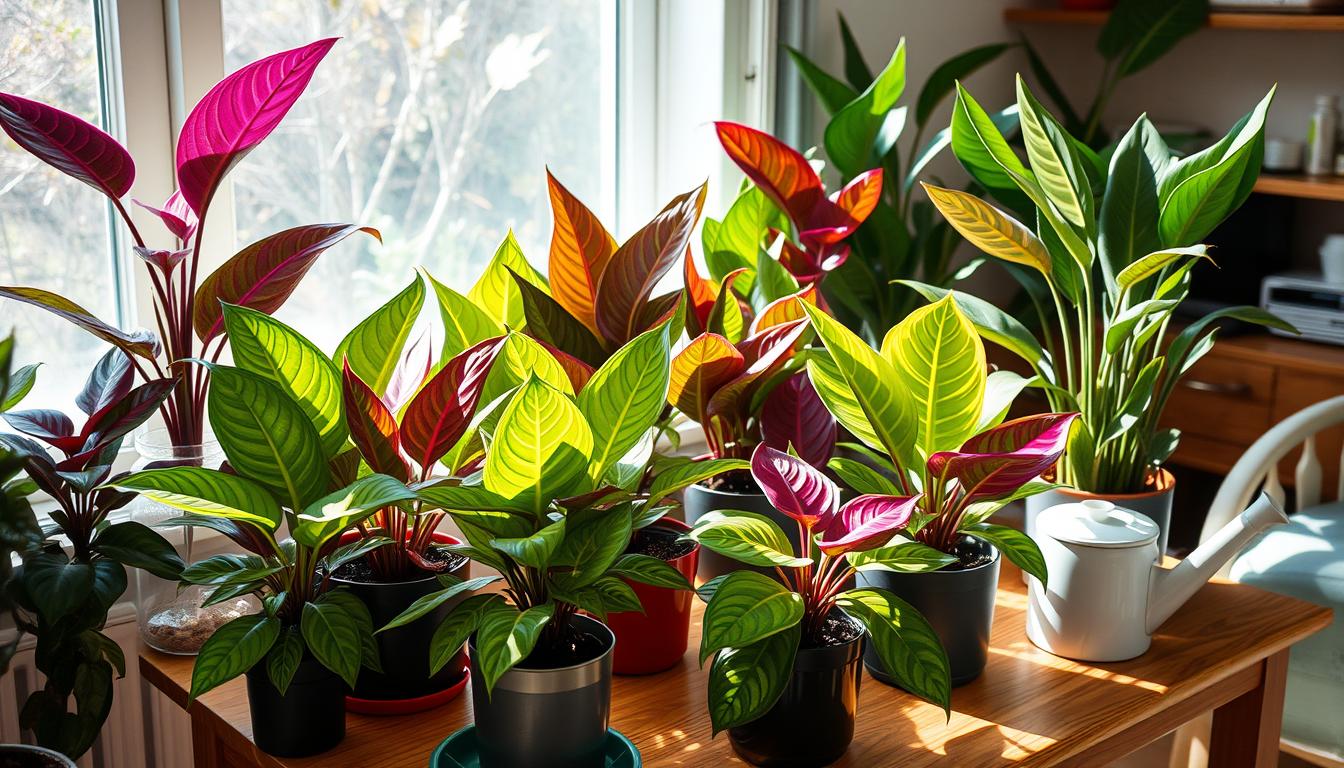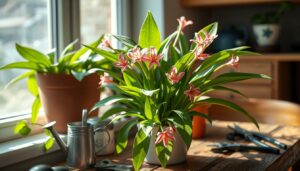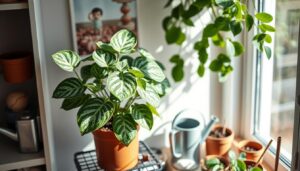Looking for safe houseplants for your pets? Calathea plants are a great pick. They have bright leaves and are safe for pets. With over 600 species, you can find the perfect one for your home.
Calatheas are safe for cats and dogs. Their cool leaf patterns make them popular. This guide will teach you how to care for your Calathea, from watering to fixing problems.
Whether you’re new to plants or not, this guide is for you. It will help you care for your Calathea and make your home beautiful. Calatheas clean the air and love humidity, making them a smart choice for your home.
Introduction to Calathea Care
Calathea plants are loved for their beauty and easy care. They have cool leaf patterns and bright colors. This makes them a favorite among many.
These plants clean the air and make rooms look nice. They are safe for people and pets. Calathea plants are great for anyone wanting to add green to their home.
There are many Calathea types, like Calathea orbifolia and Calathea zebrina. Each has its own look and way of growing. Knowing what your plant needs helps it thrive.
| Calathea Variety | Leaf Pattern | Growth Habit |
|---|---|---|
| Calathea orbifolia | Round, silver-green leaves | Upright, compact growth |
| Calathea lancifolia | Narrow, lance-shaped leaves | Tall, slender growth |
| Calathea zebrina | Striped, oval-shaped leaves | Spreading, trailing growth |
By following good Calathea care tips, you can enjoy these plants. They will stay healthy and beautiful for a long time.
Ideal Conditions for Calathea
To make your Calathea plant happy, give it the best conditions. It likes bright, indirect light. Too much direct sunlight can hurt its leaves.
Calathea plants also need a humid place, more than 50% humidity. You can use a tray with water and pebbles or a humidifier.
A Calathea plant care guide talks about creating a natural home for your plant. Here’s what you need to know:
- Light: Bright, indirect light
- Humidity: Above 50%
- Temperature: Between 65-80 degrees Fahrenheit
By following these tips, your Calathea will thrive. Each Calathea type has its own needs. With the right Calathea plant care guide, you’ll be a pro at caring for these plants. Enjoy their beauty for many years.
| Factor | Ideal Condition |
|---|---|
| Light | Bright, indirect light |
| Humidity | Above 50% |
| Temperature | Between 65-80 degrees Fahrenheit |
Watering Your Calathea
When it comes to Watering Calathea, being consistent is important. Calathea plants like moist soil but can get too wet. Check the soil every day and water only when the top inch feels dry.
Knowing the signs of too much or too little water is key. Too much water can cause roots to rot. Too little can make leaves dry and crispy. Finding the right balance keeps your Calathea happy and healthy.
Here are some tips for Watering Calathea:
- Water your Calathea once or twice a week, depending on soil moisture levels.
- Soil testing should involve probing the top one to two inches of soil for dryness.
- Misting is recommended every few days due to Calathea’s native humid jungle environment.
By following these tips and watching your Calathea’s needs, you can give it the right moisture. Remember, Calathea plant maintenance is about finding the right balance. With practice, you’ll get good at Watering Calathea quickly.
Soil and Potting Needs
Calathea plants need the right soil and potting mix. They like soil that drains well and is rich in organic matter. This helps their roots grow strong.
A good mix has peat moss, perlite, and vermiculite. These add nutrients and air for healthy growth.
Soil that breathes well helps plants absorb nutrients fast. For Calathea, the soil should be slightly acidic. Add organic stuff like vermiculite or compost to keep it draining well.
New soil should have lots of nutrients like nitrogen, phosphorus, and potassium. These are key for the plant’s health.
Best Soil Types for Calathea
- Peat moss: helps retain moisture and suppress weed growth
- Perlite: improves soil drainage and aeration
- Vermiculite: increases water retention and provides nutrients
Potting Recommendations for Calathea
Choose a pot that’s a bit bigger than the plant’s roots. Make sure it has holes for drainage. A mix of 25% orchid bark, 25% coconut coir, 25% perlite, 10% worm casting, and 5% activated charcoal is great.
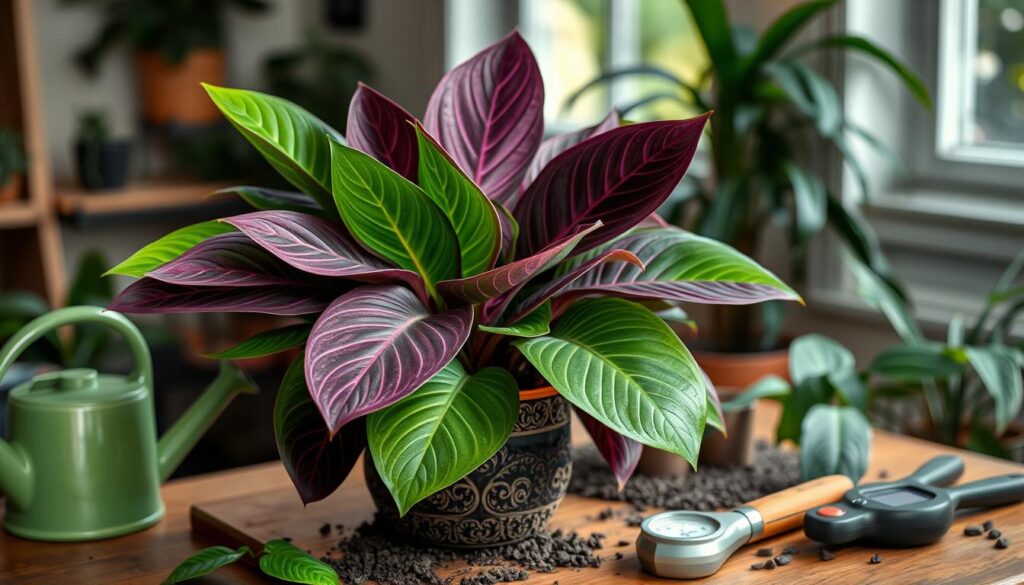
Badly draining soil can smell really bad. It’s because of rotting stuff. Use the right soil and potting mix to keep your Calathea healthy and happy.
| Soil Ingredient | Percentage |
|---|---|
| Orchid bark | 25% |
| Coconut coir | 25% |
| Perlite | 25% |
| Worm casting | 10% |
| Activated charcoal | 5% |
Fertilizing Calathea
When you learn about Indoor Calathea care, knowing about fertilization is key. Fertilizing Calathea plants helps them grow and stay healthy. Use a balanced, water-soluble fertilizer that’s half the strength it should be.
It’s important to know how often to fertilize. Young plants need more food than older ones. Plants in bright light need more food too. When it’s cooler, plants eat less.
For the best growth, pick a balanced fertilizer. Use one with a 10:10:10 or 3:1:2 ratio. Liquid fertilizers go on once a month in spring and summer. Granular ones go into the soil every six months.
Some important tips for Fertilizing Calathea are:
- Fertilize every two to four weeks when plants are growing fast.
- Choose a fertilizer with equal parts nitrogen, phosphorus, and potassium.
- Don’t fertilize in fall and winter when plants are sleeping.
By following these tips, you can give your Calathea the nutrients it needs. This makes caring for Indoor Calathea a fun and rewarding task.
Common Pests and Problems
When you learn about Calathea care essentials, knowing about common pests and problems is key. Calathea plants can get pests like spider mites, mealybugs, and scale. These pests can harm the leaves and hurt the plant’s health.
To spot these pests, look for webbing, white patches, or sticky stuff on leaves. If you see these signs, act fast to stop more harm. Check your plant often and keep it clean to avoid pests.
Calathea plants can face several issues:
- Wilting, curling, yellow, brown, or discolored leaves
- Pests like sap-suckers that can make leaves look bad
- Fungal infections from too much water that harm the roots
Knowing these problems and how to stop them helps keep your Calathea plant healthy. Stick to the right Calathea care essentials. This includes the right amount of water, humidity, and food. This way, you can avoid common pests and problems.
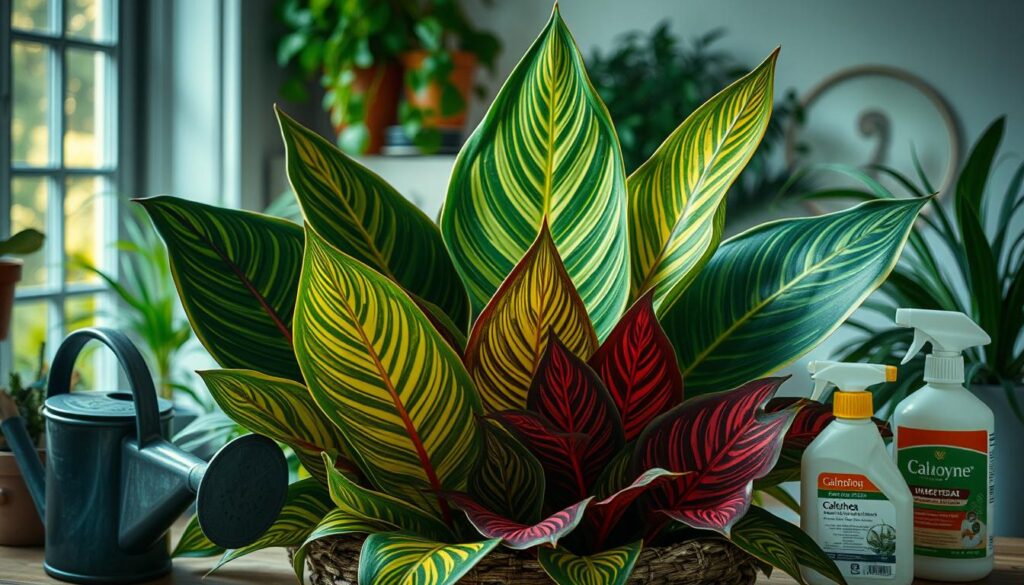
| Pest/Problem | Symptoms | Treatment |
|---|---|---|
| Spider mites | Fine webbing, yellowing leaves | Insecticidal soap or neem oil |
| Mealybugs | White powdery patches, sticky substance | Insecticidal soap or neem oil |
| Scale | Brown or black spots, sticky substance | Insecticidal soap or neem oil |
Pruning and Maintenance
As you care for your Calathea plant, pruning and maintenance are key. They help keep your plant healthy and growing. Pruning removes dead leaves, stopping disease and encouraging new growth.
Use clean, sharp tools to avoid spreading diseases. Prune in the spring and summer when the plant is growing.
For Calathea plant care, keeping leaves healthy is important. Gently dust them with a soft brush and wipe with a damp cloth. This keeps your Calathea looking great.
Some key tips for pruning and maintenance include:
- Removing dead or damaged leaves to prevent disease
- Pruning in the spring and summer for optimal growth
- Using clean, sharp tools to prevent spreading diseases
- Maintaining healthy leaves through dusting and wiping
Techniques for Maintaining Healthy Leaves
To keep your Calathea plant thriving, maintain healthy leaves. This means regular pruning and maintenance and the right growth conditions. By following these steps, your Calathea will stay beautiful for years.
Calathea Repotting Tips
As your Calathea plant grows, it will need a bigger home. Repotting can be tricky, but with the right tips, your plant will thrive. Calathea plants need a new pot every 1-2 years when they outgrow their old one.
Look for signs your plant is too big for its pot. Check for roots coming out or soil without nutrients. Choose a pot that’s only a bit bigger, with a 1-2 inch increase in size. Use a mix that drains well and water your plant well after moving it.
Step-by-Step Repotting Guide
- Prepare a new pot with a well-draining potting mix.
- Gently remove the plant from its old pot, taking care not to damage the roots.
- Inspect the roots and trim any that are damaged or circling.
- Place the plant in the new pot, adding fresh potting mix as needed.
- Water the plant thoroughly, and provide it with bright, indirect light.
After repotting, watch your plant closely. Look for signs of shock like leaf drop or yellow leaves. With good care, your plant will bounce back and keep growing.
Propagating Calathea
Learning to care for Calathea plants is fun. You can share them with friends or grow more for yourself. You can divide the plant or use leaf cuttings. With the right care, your new plants will do great.
First, pick a healthy Calathea plant with many stems. Divide it in spring or summer when it’s growing. Keep the room warm, between 60 to 70 degrees Fahrenheit (16-21 degrees Celsius). Use plastic tenting, a pebble tray, or a humidifier to keep it humid.
Methods for Successful Propagation
- Division: Carefully separate the roots and replant the separated sections in new pots with good drainage.
- Leaf cuttings: Take a healthy leaf, cut it from the plant, and plant it in a pot filled with moist soil.
For both methods, keep the soil moist and the light bright but indirect. Use a half-strength nitrogen fertilizer every two weeks. Soon, your new Calathea plants will grow and add beauty to your home.
Tips for Growing New Plants
Watering regularly is key, but don’t overdo it. This can cause soggy soil and root rot. Make sure your pots are big enough for the roots. Use a sharp knife to trim any damaged or diseased roots. By following these tips, you’ll grow healthy Calathea plants.
Troubleshooting Calathea Issues
When you care for your Calathea plant, you might face some common problems. These can harm its health and look. A good Calathea plant care guide can help you fix these issues.
Problems like yellow leaves, droopy stems, and pests are common. To find the cause, check the plant’s environment. Make sure the temperature, humidity, and light are right for your Calathea.
Common Problems and Solutions
Here are some common problems and how to fix them:
- Yellowing leaves: Check if you’re watering too much or too little. Change your watering schedule if needed.
- Droopy stems: Make sure the plant has enough humidity. Also, adjust your watering if it’s too much.
- Pest infestations: Look for pests often. Use neem-based oil to treat them if you find any.
By following a Calathea plant care guide and fixing problems, your plant can get better. Always watch your plant and change its care as needed. This will help your Calathea thrive.
Conclusion: Embrace Calathea Care
As you finish this guide on Calathea care, think about your journey. Taking care of these plants is rewarding. It needs patience, detail, and a desire to learn.
With the right steps, your Calathea will grow well. It will make your home beautiful for many years.
Final Thoughts on Caring for Your Plant
Every Calathea is different. You might need to try a few things to find what works best for yours. Don’t worry about mistakes – they help you learn.
Keep watching your Calathea closely. Change things as needed to keep it happy and healthy.
Encouragement to Explore Calathea Varieties
Once you get good at caring for Calatheas, look into different kinds. You might find the Calathea Orbifolia or the Calathea Zebrina interesting. Each one has its own special look.
Enjoy the variety of Calatheas. Let your love for plants grow as you find new ones to love.


